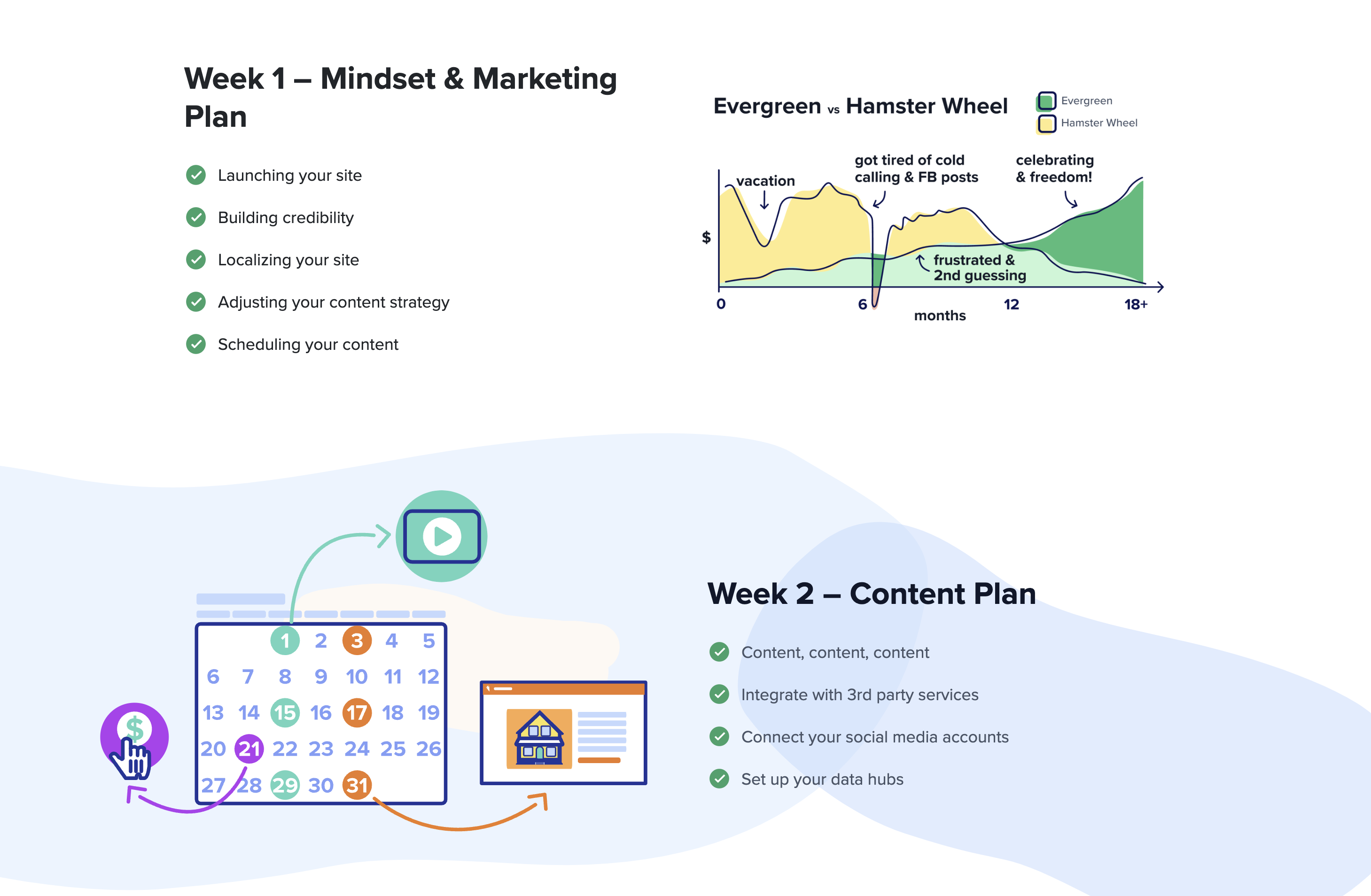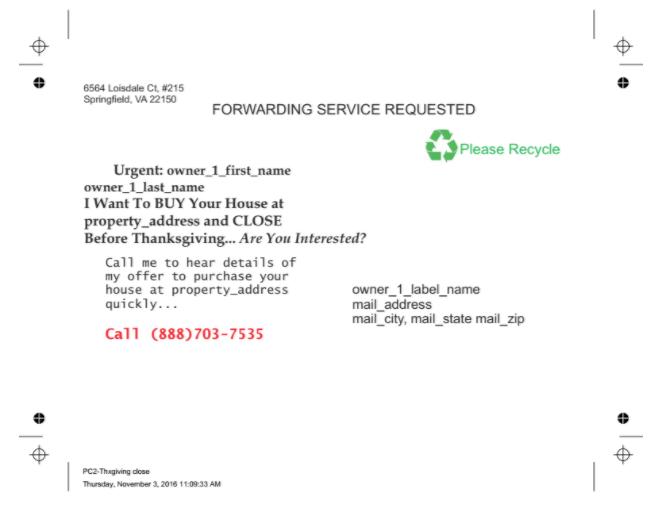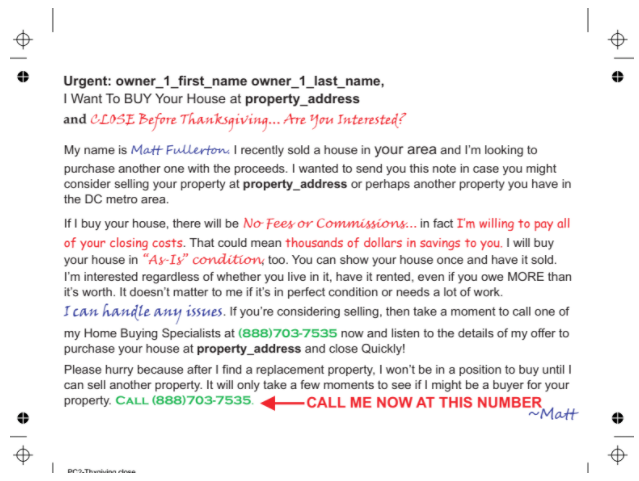
Real estate direct mail marketing is one of the most tried and true methods for investors and agents to generate leads and find deals.
Unfortunately, some mail ends up in the trash without a second look.
Mailboxes have become so overcrowded that unopened envelopes get pushed to the side.

Join Our 30 Day Authority Building Challenge: Dominate your market, build a consistent and predictable lead flow, and earn more income.
Join the ChallengeThe average mailbox is packed with junk mail, bills, and other correspondence from various sources telling you about deals or offering their services. It can be easy for an envelope containing information on real estate opportunities to land in one corner, forgotten amongst all this noise – which means missing out on potential leads!
Your only chance of sending successful direct mail is to target the right audience at the right time with the right message.
How?
Let’s not waste any more time. Here are 15 tips for getting the most out of your real estate direct mail campaign.
Table of Contents
- Tip 1: Define Your Target Audience
- Tip 2: Craft Compelling Messaging
- Tip 3: Use Eye-Catching Design
- Tip 4: Personalize Your Mailers
- Tip 5: Offer Valuable Content
- Tip 6: Include Clear Calls to Action
- Tip 7: Test Different Formats and Messages
- Tip 8: Integrate Direct Mail with Digital Marketing
- Tip 9: Monitor and Analyze Results
- Tip 10: Use High-Quality Materials
- Tip 11: Leverage Data for Personalization
- Tip 12: Establish a Consistent Schedule
- Tip 13: Follow Up with Recipients
- Tip 14: Stay Compliant with Regulations
- Tip 15: Continuously Improve and Adapt
- Best Real Estate Direct Mail Providers
- Direct Mail Advice from Carrot Members
15 Real Estate Direct Mail Tips from Industry Experts
Tip 1: Define Your Target Audience
Importance of Defining Target Audience: Defining your target audience is the foundation of any successful marketing campaign, including real estate direct mail. Understanding who your ideal recipients are allows you to tailor your messaging and design to resonate with them.
By targeting the right audience, you can increase the effectiveness of your direct mail efforts and maximize your return on investment.
Advice on Identifying and Segmenting Target Demographics: Conducting thorough research and analysis is crucial to define your target real estate direct mail audience effectively. Start by examining your current customer base and identifying common characteristics, such as demographics (age, income, location), behaviors, and preferences.
Additionally, consider the specific properties or services you offer and the unique needs of your target market.
Once you understand your audience, segment them into distinct groups based on relevant criteria. This segmentation allows you to create personalized messaging and offers that speak directly to the needs and interests of each segment. Utilize data analytics tools and CRM systems to track and analyze customer interactions, preferences, and feedback, further refining your targeting strategy.
By defining your target audience and segmenting them effectively, you can ensure that your real estate direct mail campaigns reach the right people with the right message, increasing the likelihood of engagement and conversion.
Tip 2: Craft Compelling Messaging
Creating Engaging Content for Direct Mail: In real estate direct mail, the content you deliver to your audience is paramount. Your messaging serves as the primary vehicle for communicating your value proposition, highlighting property features, and ultimately convincing recipients to take action.
Engaging content captures attention, sparks interest, and drives desired behaviors, making it a critical component of any successful direct mail campaign.
Tips on Writing Effective Copy and Headlines: When crafting messaging for your real estate direct mailers, it’s essential to focus on clarity, relevance, and persuasion. Here are some expert tips to help you write compelling copy and headlines:
- Know Your Audience: Tailor your messaging to resonate with your target audience’s needs, preferences, and pain points. Use language and tone that speaks directly to their interests and aspirations.
- Lead with Benefits: Highlight your properties or services’ unique benefits and value propositions. Focus on how your offerings can solve problems, fulfill desires, or improve the lives of your audience.
- Keep it Concise: In direct mail, brevity is key. Capture attention with concise, punchy headlines and copy that get straight to the point. Avoid unnecessary jargon or fluff and aim for clarity and simplicity.
- Create Urgency: Incorporate language that instills a sense of urgency or scarcity to motivate recipients to act quickly. Limited-time offers, exclusive deals, and time-sensitive incentives can encourage immediate responses.
- Use Compelling Headlines: Your headline is the first thing recipients will see, so make it count. Craft attention-grabbing headlines that pique curiosity, evoke emotion or address a specific pain point or desire.
- Include a Clear Call to Action (CTA): Every piece of direct mail should include a clear and compelling call to action that tells recipients exactly what you want them to do next. Whether visiting a website, scheduling a showing, or contacting you for more information, make your CTA prominent and easy to follow.
By following these expert tips and techniques, you can create compelling messaging that resonates with your audience, drives engagement, and ultimately leads to successful real estate direct mail campaigns.
Tip 3: Use Eye-Catching Design
The Role of Design in Direct Mail Success: In real estate direct mail, design captures recipients’ attention and conveys your message effectively. Your mailers’ visual appeal can significantly impact their effectiveness and determine whether they are opened, read, and acted upon.
A well-designed direct mail piece grabs attention and communicates professionalism, credibility, and value, instilling confidence in your brand and offerings.
Advice on Creating Visually Appealing Mailers: When designing your real estate direct mailers, there are several key principles and best practices to remember. Here are some expert tips to help you create visually appealing mailers that stand out:
- Focus on Branding: Ensure that your direct mailers reflect your brand identity, including your logo, colors, fonts, and overall aesthetic. Consistent branding helps reinforce brand recognition and trust among recipients.
- Choose High-Quality Imagery: Incorporate high-quality images that showcase your properties or services in the best light. Use professional photography to highlight key features, amenities, and unique selling points.
- Utilize White Space: Don’t overcrowd your mailers with too much text or imagery. Utilize white space strategically to create balance, clarity, and visual interest. White space helps draw attention to key elements and prevents the design from feeling overwhelming.
- Prioritize Readability: Ensure that your copy is easy to read and understand at a glance. Use legible fonts, appropriate font sizes, and a clear hierarchy to guide recipients through the content effortlessly.
- Add Visual Elements: Incorporate eye-catching visual elements such as icons, illustrations, or graphics to enhance the appeal of your mailers and reinforce your message. Visual elements can help break up text, highlight important information, and create visual interest.
- Experiment with Formats: Consider experimenting with different formats, sizes, and folds to make your mailers stand out in the mailbox. Unique formats can grab attention and intrigue recipients, increasing the likelihood of engagement.
- Test and Iterate: Don’t be afraid to test different design elements, layouts, and formats to see what resonates best with your audience. Continuously gather feedback, analyze performance data, and iterate on your designs to optimize results over time.
Following these expert tips and principles, you can create visually appealing real estate direct mailers that captivate recipients, communicate your message effectively, and drive desired actions.
Tip 4: Personalize Your Mailers
Personalization in Direct Mail Campaigns: Personalization is a powerful tool in real estate direct mail campaigns, allowing you to tailor your messaging and offers to individual recipients’ specific needs, preferences, and interests.
Personalizing your mailers can create a more meaningful and relevant experience for recipients, increasing the likelihood of engagement and conversion. Personalized mailers demonstrate that you understand and care about the recipient’s unique circumstances, fostering a stronger connection and sense of trust with your audience.
Tips on Incorporating Personalization Tactics: Effective tactics and strategies are needed when personalizing your real estate direct mailers. Here are some expert tips to help you incorporate personalization into your campaigns:
- Use Recipient Names: Address recipients by their names in your mailers to create a more personal and engaging experience. Including the recipient’s name in the headline or greeting can grab attention and make the mailer feel more tailored to them.
- Segment Your Audience: Segment your mailing list based on relevant criteria such as demographics, location, interests, or past interactions. By dividing your audience into distinct groups, you can create more targeted and personalized messaging that resonates with each segment.
- Tailor Offers and Recommendations: Customize your offers, promotions, and recommendations based on the preferences and behavior of individual recipients. Use data analytics and customer insights to identify relevant offers and incentives likely to appeal to each recipient.
- Include Personalized Content: Create personalized content that speaks directly to the recipient’s needs, challenges, or aspirations. Highlight relevant property listings, neighborhood information, or market trends specific to the recipient’s interests and preferences.
- Incorporate Dynamic Content: Utilize dynamic content and variable data printing to personalize elements of your mailers, such as images, headlines, and offers, based on recipient data. Dynamic content allows you to create highly customized and relevant mailers at scale.
- Follow Up with Personalized Communication: After sending out your mailers, follow up with personalized communication to further engage recipients and nurture leads. Use personalized emails, phone calls, or direct mail follow-ups to continue the conversation and provide additional value.
By implementing these expert tips and personalization tactics, you can create more impactful and effective real estate direct mailers that resonate with recipients personally, driving engagement and results.
Tip 5: Offer Valuable Content
Providing Value to Recipients: Providing valuable content is essential in real estate direct mail campaigns as it helps to establish trust, credibility, and authority with recipients. By offering valuable information, insights, and resources, you position yourself as a helpful and knowledgeable resource in the eyes of your audience.
Valuable content captures attention, keeps recipients engaged, encourages interaction, and fosters positive associations with your brand. Whether it’s educational content, market insights, or helpful tips, providing value demonstrates your commitment to serving the needs of your audience and can ultimately lead to increased engagement and conversions.
Advice on Types of Content to Include: Several effective approaches and content types must be considered when offering valuable content in your real estate direct mailers. Here are some expert recommendations on the types of content to include:
- Educational Guides and Resources: Create educational guides, e-books, or resource kits that provide valuable information and insights about buying, selling, or investing in real estate. Topics could include home buying tips, seller’s guides, neighborhood profiles, market trends, and investment strategies.
- Market Updates and Insights: Share relevant market updates, industry trends, and local market insights to keep recipients informed and empowered. Provide analysis and commentary on key market indicators, such as home prices, inventory levels, and interest rates, to help recipients make informed decisions.
- Property Listings and Showcase: Showcase your available properties or listings in your direct mailers, highlighting key features, amenities, and photos. Include detailed property descriptions, virtual tours, and interactive elements to engage recipients and encourage them to explore further.
- Client Testimonials and Success Stories: Share client testimonials, success stories, and case studies to demonstrate your track record of success and the value you’ve delivered to past clients. Highlight positive experiences, outcomes, and testimonials to build trust and credibility with potential prospects.
- Helpful Tips and Advice: Offer practical tips, advice, and how-to guides on topics relevant to your audience’s interests and needs. Provide actionable home maintenance, staging, landscaping, and renovation tips or advice on navigating the buying or selling process.
- Exclusive Offers and Promotions: Provide exclusive offers, discounts, or promotions to incentivize recipients to take action. Offer special deals on services, incentives for referrals, or limited-time discounts on properties to create a sense of urgency and encourage engagement.
By including valuable content in your real estate direct mailers, you can provide recipients with useful information, insights, and resources that demonstrate your expertise, build trust, and drive engagement. Offering value enhances the effectiveness of your direct mail campaigns and strengthens your relationship with your audience over time.
Tip 6: Include Clear Calls to Action
Guiding Recipients to Take Action: Clear calls to action (CTAs) are essential in real estate direct mail campaigns as they guide recipients on what action to take next. Whether scheduling a showing, visiting a website, or contacting you for more information, a well-crafted CTA prompts recipients to engage with your brand and move closer to conversion.
Without a clear CTA, recipients may be unsure of what steps to take, resulting in missed opportunities and ineffective campaigns. By including clear and compelling CTAs in your direct mailers, you can encourage recipients to take the desired action and drive results for your business.
Tips on Crafting Effective Calls to Action: Effective calls to action require careful language, placement, and design consideration. Here are some expert tips to help you create compelling CTAs that drive action:
- Be Clear and Specific: Your CTA should clearly state the desired action and specify what recipients should do next. Use actionable language such as “Call Now,” “Schedule a Tour,” or “Visit Our Website” to prompt immediate action.
- Create a Sense of Urgency: Incorporate urgency into your CTAs to motivate recipients to act quickly. Use phrases like “Limited Time Offer,” “Act Now,” or “Don’t Miss Out” to create a sense of urgency and encourage immediate responses.
- Highlight Benefits: Communicate the benefits of action to incentivize recipients to engage. Whether saving time, finding their dream home, or accessing exclusive offers, emphasize the value proposition of taking action.
- Make it Visually Stand Out: Ensure your CTA stands out from the rest of the mailer. Use contrasting colors, bold fonts, or visual elements such as arrows or buttons to draw attention to the CTA and make it easy to find.
- Keep it Simple: Keep your CTA concise and easy to understand. Avoid using overly complicated language or multiple CTAs competing for attention. Focus on one clear and compelling action that you want recipients to take.
- Place it Strategically: Position your CTA in a prominent location where it’s highly visible and easily accessible. Place it near the top or bottom of the mailer, and consider repeating it throughout the content for maximum impact.
By following these expert tips and best practices, you can create clear and compelling calls to action that prompt recipients to take action and drive the desired results for your real estate direct mail campaigns.
Tip 7: Test Different Formats and Messages
Benefits of A/B Testing: A/B testing, or split testing, is a valuable strategy in real estate direct mail campaigns that allows you to compare different formats and messages to determine which resonates most with your audience.
By conducting A/B tests, you can gain insights into what elements of your mailers most effectively drive engagement and conversions. Testing different formats, messages, designs, and offers enables you to optimize your campaigns for maximum impact and ROI.
A/B testing provides valuable data and insights to inform future campaign decisions, helping you refine your approach and improve results over time.
Advice on Testing Strategies and Tools: Implementing effective A/B testing strategies requires careful planning, execution, and analysis. Here are some expert tips and tools to help you conduct successful A/B tests in your real estate direct mail campaigns:
- Define Clear Objectives: Define clear objectives and hypotheses for your A/B tests. Determine what specific elements you want to test (e.g., messaging, design, offer) and what metrics you will use to measure success (e.g., response rate, conversion rate).
- Test One Variable at a Time: When conducting A/B tests, focus on testing one variable at a time to isolate the impact of each element. This allows you to assess individual factors’ effectiveness and avoid confounding variables.
- Split Your Audience: Divide your mailing list into random, equal-sized segments to create test and control groups. Send different variations of your mailers to each group and track their performance separately to determine which version performs better.
- Track and Analyze Results: Monitor the performance of your A/B tests closely and track key metrics to measure the impact of each variation. Use analytical tools and software to collect and analyze data, identify trends, and draw meaningful insights from your test results.
- Iterate and Optimize: Use the insights gained from your A/B tests to iterate and optimize your future mailers. Implement changes based on successful variations and continue to test and refine your approach over time to improve results.
- Utilize Testing Tools: Take advantage of A/B testing tools and software available to streamline the testing process and gather actionable insights. Tools like Google Optimize, Optimizely, and Mailchimp’s A/B testing feature offer robust functionality for designing and analyzing experiments.
By incorporating A/B testing into your real estate direct mail campaigns and following these expert strategies, you can gain valuable insights, improve campaign performance, and optimize your marketing efforts for success.
Tip 8: Integrate Direct Mail with Digital Marketing
Integrating Direct Mail with Digital Channels: In today’s digital age, integrating direct mail with digital marketing channels is essential for maximizing reach, engagement, and conversion opportunities.
By combining the strengths of both offline and online channels, you can create cohesive and multi-dimensional marketing campaigns that resonate with your audience across various touchpoints. Integrating direct mail with digital channels allows you to leverage the unique benefits of each medium while complementing and reinforcing your messaging for greater impact.
From driving website traffic and capturing leads to nurturing prospects and tracking campaign performance, cross-channel integration enables you to create a seamless and immersive brand experience for your audience.
Tips on Cross-Channel Marketing Strategies: To effectively integrate direct mail with digital marketing channels, consider implementing the following expert tips and cross-channel marketing strategies:
- Consistent Branding and Messaging: Ensure consistency in branding and messaging across all channels to create a cohesive and unified brand experience for your audience. Align your direct mailers with your digital assets, such as your website, social media, and email, to reinforce your brand identity and messaging.
- Use QR Codes and Personalized URLs (PURLs): Incorporate QR codes and personalized URLs (PURLs) into your direct mailers to seamlessly bridge the gap between offline and online interactions. QR codes can direct recipients to specific landing pages or digital content, while PURLs can track individual responses and personalize the user experience.
- Promote Social Media Engagement: Encourage recipients to connect with your brand on social media platforms by including social media icons, handles, or hashtags in your direct mailers. Drive engagement by promoting user-generated content, hosting contests, or sharing exclusive offers on social channels.
- Retargeting and Remarketing Campaigns: Implement retargeting and remarketing campaigns to re-engage recipients who have interacted with your direct mailers but have not yet converted. Use digital tracking tools and cookies to deliver targeted ads and personalized content based on user behavior across digital channels.
- Email Follow-Up Sequences: Create email follow-up sequences to reinforce your direct mail messaging and nurture leads through the sales funnel. Send personalized emails to recipients engaged with your direct mailers, providing additional information, offers, or incentives to encourage further action.
- Track and Measure Campaign Performance: Utilize tracking tools and analytics to monitor the performance of your cross-channel marketing campaigns. Measure key metrics such as response rates, website traffic, conversion rates, and ROI to assess the effectiveness of each channel and optimize your marketing efforts accordingly.
You can enhance the reach, effectiveness, and overall success of your real estate marketing campaigns by implementing these cross-channel marketing strategies and integrating direct mail with digital channels.
Tip 9: Monitor and Analyze Results
Tracking and Analyzing Campaign Performance: Monitoring and analyzing campaign performance is crucial for evaluating the effectiveness of your direct mail efforts and optimizing future marketing strategies.
Tracking key metrics allows you to assess your campaigns’ impact, identify improvement areas, and make data-driven decisions to achieve better results.
By analyzing campaign data, you can gain valuable insights into customer behavior, campaign effectiveness, and ROI, enabling you to refine your approach and maximize your marketing investment.
Advice on Key Metrics to Monitor: When monitoring and analyzing direct mail campaign results, focusing on key metrics that provide insights into campaign performance and effectiveness is essential. Here are some expert-recommended metrics to monitor:
- Response Rate: Measure the percentage of recipients who respond to your direct mail campaign by taking the desired action, such as visiting a website, calling a phone number, or making a purchase. A higher response rate indicates greater campaign engagement and effectiveness.
- Conversion Rate: Track the percentage of recipients who complete a desired action, such as making a purchase or scheduling a consultation, as a result of your direct mail campaign. A higher conversion rate indicates that your campaign effectively drives desired outcomes and generates tangible results.
- ROI (Return on Investment): Calculate the return on investment for your direct mail campaign by comparing the cost of the campaign to the revenue generated or cost savings achieved. A positive ROI indicates that your campaign generates value and contributes to your bottom line.
- Cost per Acquisition (CPA): Determine the cost per acquisition by dividing the total campaign cost by the number of new customers or leads acquired due to the campaign. Monitoring CPA helps you assess the efficiency and cost-effectiveness of your acquisition efforts.
- Customer Lifetime Value (CLV): Evaluate the long-term value of acquired customers by calculating the average revenue generated from a customer over their lifetime. Monitoring CLV helps you prioritize high-value customer segments and tailor your marketing efforts accordingly.
- Response Attribution: Analyze response attribution to understand which channels, messages, or offers drive the most responses and conversions. You can optimize future campaigns for better results by identifying the most effective tactics.
By tracking and analyzing these key metrics, you can gain valuable insights into the performance of your direct mail campaigns, identify areas for improvement, and make informed decisions to enhance your marketing strategy and drive success.
Tip 10: Use High-Quality Materials
Using Quality Materials for Mailers: The quality of materials used in your direct mail campaign can significantly impact its effectiveness and perception among recipients. High-quality materials enhance the visual appeal of your mailers and convey professionalism, credibility, and value to your audience.
Investing in premium materials demonstrates your commitment to delivering a superior experience and reflects positively on your brand reputation. Additionally, durable and well-crafted materials are more likely to withstand handling and transportation, ensuring that your message reaches recipients intact and leaves a lasting impression.
Tips on Selecting Materials and Printing Options: When selecting materials and printing options for your direct mail campaign, consider the following expert tips to ensure optimal results:
- Paper Quality: Choose high-quality paper stock that is thick, durable, and has a professional finish. Opt for paper with a weight of at least 100 lbs to give your mailers a substantial feel and prevent them from appearing flimsy or cheap.
- Finish and Coating: Select a finish and coating that enhances your mailers’ visual appeal and tactile experience. Glossy finishes can add color, shine, and vibrancy, while matte finishes offer a sophisticated, understated look. Consider incorporating special coatings such as UV coating or spot varnish to highlight specific elements and add a touch of elegance.
- Printing Technique: Explore different printing techniques, such as offset printing, digital printing, or letterpress, to achieve the desired quality and effect for your mailers. Offset printing provides high-quality, consistent results for large-volume runs, while digital printing offers flexibility and customization for smaller runs and variable data printing.
- Color Selection: Use vibrant colors and high-resolution graphics to capture attention and create visual interest. Choose colors that align with your brand identity and evoke your audience’s desired emotions and associations. Consider incorporating color psychology principles to influence perception and response.
- Texture and Finish: Experiment with textured papers, embossing, or foil stamping to add depth, dimension, and tactile appeal to your mailers. These tactile elements create a sensory experience that engages recipients and makes your mailers stand out.
By prioritizing quality materials and printing options in your direct mail campaign, you can elevate the perceived value of your brand, enhance engagement with your audience, and maximize the effectiveness of your marketing efforts.
Tip 11: Leverage Data for Personalization
Role of Data in Personalization: Leveraging data for personalization is essential for creating targeted and relevant messaging that resonates with your audience.
Data-driven personalization allows you to tailor your direct mail campaigns to individual recipients’ specific needs, preferences, and behaviors, increasing engagement, response, and conversion rates.
By harnessing the power of data, you can segment your audience, customize your messaging, and deliver personalized experiences that drive meaningful interactions and foster stronger connections with your prospects and customers.
Advice on Leveraging Data for Targeted Messaging: To effectively leverage data for targeted messaging in your direct mail campaigns, consider the following expert advice:
- Collect Relevant Data Points: Collect relevant data points about your audience, including demographics, psychographics, purchase history, browsing behavior, and engagement metrics. Use internal and external data sources to build comprehensive customer profiles and gain insights into their preferences and interests.
- Segment Your Audience: Segment your audience into distinct groups based on common characteristics, preferences, or behaviors. Use segmentation criteria such as age, gender, location, buying behavior, or product interests to create targeted audience segments that allow you to deliver personalized messaging to each group.
- Dynamic Content Personalization: Implement dynamic content personalization techniques to tailor your messaging and offers to the unique attributes of each recipient. Use variable data printing (VDP) to dynamically generate customized content based on individual customer data, such as personalized greetings, product recommendations, or exclusive offers.
- Behavioral Targeting: Leverage strategies to deliver relevant messaging based on recipient actions, interactions, or engagement levels. Use data-driven triggers and automation to send personalized mailers in response to specific behaviors, such as website visits, email opens, or previous purchases.
- Predictive Analytics: Harness the power of predictive analytics to anticipate customer needs and preferences and proactively deliver targeted messaging before they even realize it. Use machine learning algorithms and predictive models to analyze historical data, identify patterns, and predict future behavior, enabling you to tailor your campaigns for maximum impact.
By incorporating data-driven personalization techniques into your direct mail campaigns, you can create more relevant, engaging, and impactful messaging that resonates with your audience and drives better results.
Tip 12: Establish a Consistent Schedule
Consistency in Direct Mail Campaigns: Consistency is key to the success of your direct mail campaigns. Establishing a regular mailing schedule creates a predictable cadence of communication with your audience, which helps build brand recognition, trust, and loyalty over time.
Consistent mailings ensure that your brand stays top-of-mind with recipients and reinforces your marketing message, increasing the likelihood of engagement and response.
Additionally, a consistent schedule demonstrates professionalism and reliability, positioning your brand as a trusted authority in your industry and enhancing your credibility among customers.
Tips on Setting Up a Regular Mailing Schedule: To effectively establish a consistent mailing schedule for your direct mail campaigns, consider the following expert tips:
- Define Your Frequency: Determine how often you will send out mailers to your audience based on your campaign objectives, audience preferences, and budget constraints. Consistency is key whether you mail weekly, bi-weekly, or monthly. Aim for a frequency that strikes the right balance between staying top-of-mind and avoiding over-saturation.
- Plan Ahead: Create a comprehensive content calendar outlining your mailing schedule for the upcoming weeks or months. Plan your mailings to ensure a steady flow of content and avoid last-minute scrambling. Consider seasonal trends, holidays, and special events that may impact your campaign timing and messaging.
- Stick to a Routine: Stick to your established mailing schedule religiously to maintain consistency and reliability. Set deadlines for content creation, design, printing, and mailing to ensure the timely execution of each campaign. Establishing a routine helps streamline the workflow and ensures that your mailers go out on time, every time.
- Monitor and Adjust: Regularly monitor the performance of your direct mail campaigns and adjust your mailing schedule as needed. Analyze key metrics such as response rates, conversion rates, and ROI to determine your schedule’s effectiveness and identify optimization opportunities. Experiment with different frequencies and timing to find the optimal cadence that maximizes engagement and response.
- Communicate with Recipients: Keep your audience informed about your mailing schedule and set expectations for when they can expect to receive mail from you. Use email or other channels to communicate upcoming promotions, special offers, or important updates to ensure recipients know your mailings and anticipate them eagerly.
By establishing a consistent mailing schedule for your direct mail campaigns, you can maintain a steady flow of communication with your audience, reinforce your brand message, and drive better results over time.
Tip 13: Follow Up with Recipients
Importance of Follow-Up Communications: Following up with recipients after sending out direct mail is crucial for nurturing relationships, driving engagement, and maximizing the impact of your campaign.
While your initial mailer may capture recipients’ attention, follow-up communications allow you to reinforce your message, address any questions or concerns, and guide recipients toward the desired action.
By staying engaged with your audience through follow-up efforts, you demonstrate your commitment to their needs, build trust and rapport, and increase the likelihood of conversion.
Advice on Follow-Up Strategies: To effectively follow up with recipients after sending out direct mail, consider implementing the following expert strategies:
- Multi-Channel Approach: Leverage a multi-channel approach to follow up with recipients through various touchpoints, such as email, phone calls, social media, or personalized landing pages. By reaching out through multiple channels, you increase the chances of connecting with recipients and engaging them on their preferred communication platforms.
- Timely Follow-Up: Follow up with recipients promptly after sending out your initial mailer to capitalize on their interest and keep your brand top-of-mind. Aim to follow up within a few days to a week to maintain momentum and reinforce your message while it’s still fresh in recipients’ minds.
- Personalized Outreach: Personalize your follow-up communications to resonate with individual recipients and address their needs, preferences, and interests. Use recipient data and insights from your initial mailer to tailor your follow-up messages and offers for maximum relevance and impact.
- Provide Value: In your follow-up communications, offer additional value or incentives to incentivize recipients to take the desired action. Whether it’s exclusive discounts, bonus content, or personalized recommendations, adding value encourages recipients to engage further with your brand and move closer to conversion.
- Persistent Engagement: Be persistent in your follow-up efforts without being pushy or intrusive. Follow up multiple times over a reasonable timeframe to increase the chances of getting a response or conversion. Use a mix of follow-up tactics, such as reminder emails, follow-up calls, and targeted ads, to maintain consistent engagement with recipients.
By implementing strategic follow-up strategies, you can extend the reach and impact of your direct mail campaigns, nurture relationships with recipients, and drive higher conversion rates over time.
Tip 14: Stay Compliant with Regulations
Adhering to Legal Regulations: Compliance with legal regulations is essential when conducting direct mail campaigns to ensure ethical practices, protect consumer privacy, and avoid potential legal repercussions. Direct mail is subject to various regulations and laws governing consumer privacy, data protection, advertising, and marketing practices.
Failure to comply with these regulations can result in fines, penalties, damage to your reputation, and even legal action against your business. By staying compliant with regulations, you demonstrate your commitment to ethical conduct, build trust with your audience, and safeguard your business from potential risks.
Tips on Compliance and Best Practices: To maintain compliance with regulations and adhere to best practices in direct mail marketing, consider implementing the following expert tips:
- Understand Applicable Regulations: Familiarize yourself with relevant regulations and laws governing direct mail marketing in your jurisdiction, including the CAN-SPAM Act, GDPR (General Data Protection Regulation), CASL (Canadian Anti-Spam Legislation), and industry-specific regulations. Stay updated on regulation changes and seek legal guidance to ensure compliance.
- Obtain Consent and Permissions: Obtain explicit consent and permissions from recipients before sending them direct mail, especially for marketing communications. Ensure that recipients have willingly opted in to receive your mail and provide clear mechanisms for opting out or unsubscribing from future communications.
- Respect Consumer Privacy: Respect consumer privacy rights by handling personal data responsibly and transparently. Safeguard sensitive information, such as names, addresses, and contact details, and adhere to data protection principles when collecting, storing, and processing customer data.
- Honor Opt-Out Requests: Honor opt-out requests and unsubscribe requests promptly and efficiently. Provide recipients with easy-to-use opt-out mechanisms, such as unsubscribe links or preference centers, and respect their communication frequency and content preferences.
- Disclose Relevant Information: Disclose relevant information in your direct mail communications, including your identity, contact information, and the purpose of the communication. Provide recipients with clear and accurate information about your products, services, offers, and terms and conditions.
- Monitor Compliance: Regularly monitor your direct mail practices to ensure compliance with regulations and best practices. Conduct internal audits, review your processes and procedures, and implement controls to mitigate compliance risks. Stay informed about industry standards and emerging trends in direct mail marketing to adapt your practices accordingly.
By staying compliant with regulations and following best practices in direct mail marketing, you can build trust with your audience, protect consumer privacy, and maintain the integrity of your brand while maximizing the effectiveness of your campaigns.
Tip 15: Continuously Improve and Adapt
The Need for Ongoing Optimization: In the dynamic landscape of direct mail marketing, continuous improvement and adaptation are essential to staying competitive, maximizing results, and meeting evolving customer needs and preferences.
By continuously optimizing your direct mail campaigns, you can identify areas for improvement, refine your strategies, and enhance the effectiveness of your marketing efforts over time. Ongoing optimization allows you to stay ahead of the curve, capitalize on emerging trends, and maintain relevance in an ever-changing market environment.
Whether refining your targeting strategies, improving your messaging, or adopting new technologies, embracing a culture of continuous improvement ensures that your direct mail campaigns remain effective and impactful.
Advice on Staying Ahead of Trends and Changes: To stay ahead of trends and changes in direct mail marketing and continuously improve your campaigns, consider implementing the following expert advice:
- Collect and Analyze Data: Gather data from your direct mail campaigns, including response rates, conversion rates, and customer feedback, to gain insights into their performance. Use analytics tools to analyze this data and identify patterns, trends, and areas for optimization.
- Test and Iterate: Implement A/B testing and experimentation to test different variables, such as messaging, design, offers, and timing, and determine what resonates best with your audience. Iterate your findings and refine your strategies based on the results to improve campaign performance.
- Stay Informed: Stay informed about industry trends, best practices, and emerging technologies in direct mail marketing. Keep abreast of changes in consumer behavior, regulatory requirements, and technological advancements that may impact your campaigns. Attend industry conferences, workshops, and webinars, and engage with thought leaders and experts to stay ahead of the curve.
- Embrace Innovation: Embrace innovation and leverage new technologies and techniques to enhance the effectiveness of your direct mail campaigns. Explore options such as variable data printing, augmented reality, personalized URLs (PURLs), and interactive mailers to create engaging and impactful experiences for your recipients.
- Seek Feedback: Solicit feedback from recipients, customers, and stakeholders to gain valuable insights into their preferences, needs, and expectations. Use this feedback to refine your campaigns, address pain points, and deliver a more personalized and relevant experience for your audience.
- Stay Agile: Remain flexible and adaptable in your approach to direct mail marketing, and be prepared to pivot quickly in response to changing market conditions, customer feedback, or competitive pressures. Adopt an agile mindset and embrace change as an opportunity for growth and innovation.
By continuously improving and adapting your direct mail campaigns, you can stay ahead of the curve, drive better results, and maintain a competitive edge in the market. Embrace a culture of experimentation, innovation, and learning to unlock the full potential of your direct mail marketing efforts.
Best Real Estate Direct Mail Providers
If you’re a beginner at real estate, you might wonder what tool you should use to create and send your direct mail.
Here are the four of the best direct mail providers:
Direct Mail Advice From Carrot Members
Given our reader’s interest in sending direct mail, we thought it appropriate to discuss what direct mail strategies work for our clients today.
And then we thought to ourselves, “Hey, we know a lot of real estate investors” (also known as all our AMAZING clients).
So, we asked them what strategies they use when sending direct mail. This is a compilation of their techniques, results, and advice. Here’s what they’re doing.
Frequency

Brad Chandler, a real estate investor at Express HomeBuyers, sends direct mail to prospects monthly. To manage high volume, he splits their mailing list into groups and sends a batch of mail to one group each week.
This is a postcard that Brad sends to his list.
Front:

Back:


Daniel DiGiacomo, owner and investor at Baltimore Wholesale Property, sends 10,000 pieces of direct mail every month. Additionally, he sends between 1,000 and 1,500 yellow letters each month. On the yellow letters, he has them designed to look like they’re written by hand.
These are some pieces that Daniel sends regularly.




Response Rate
Emphasizing that direct mail is a numbers game, Brad said,
“Sending out a couple hundred postcards probably won’t get you a deal. We typically see response rates of 0.5%-1.5%. Our leads convert at around 3%.”
Those percentages aren’t uncommon in the direct mail world, with the average across all industries at 4.25% for postcards.
Daniel has somehow surpassed the average response rate with his direct mail campaign. He sees a 7%-10% response rate on his postcards and a 20% response rate on his yellow letters. Appropriately, Daniel claims that his success comes from choosing his mailing list wisely.
Build a Quality List
“List quality is the most important part of direct mail,”
says Daniel,
“I like to target absentee, out of state owners that are likely older (55 and up).”
As for Brad’s list, his data suggests that the best performers are homeowners with 70% and higher equity, out-of-state homeowners, and probate.
Also worthy of note, Brad says,
“Response rates will be highest when you first mail a list. There will be a lot of people asking to be removed from mailings. As you continue to mail the list, response rates will decrease but you will get high quality leads.”
Quality Leads

As a tip, real estate investor Edward Beck from Quick Sell Buyers explains why quality leads are more important than quantity of leads.
He says,
“The main difference I have from all the others is that my stuff is honest and not smoke and mirrors.”
He believes that honesty matters to prospects today because, in the marketing world, they see so little of it.
“I’m not leading the seller to believe I’m going to pay full price or that they would get a better deal not having a middle man (agent). I believe this is the biggest shortcoming with other mail pieces.”
Indicating that dishonest marketing techniques bring in low-quality leads, he continues,
“Yes they will have a higher response rate but when they make an offer the sellers are in a different frame of mind… The market is flooded with [dishonesty] and I believe [prospects] can smell it.”
Test & Iterate
As with all marketing, testing is key. You can test the copy, images, and postcard style for direct mail.
For A/B testing, Brad explains that sticking with a single postcard makes it much easier to test accurately.
“We think it is smarter to stick with one postcard. The reason is that sticking to one postcard makes it easier to A/B test new ideas.”
But it’s not just testing that counts. The application of the test’s findings makes the difference. On this, Brad says,
“We continuously iterate our copy and design to improve the conversion rate of the winning postcard.”
Supplemental Marketing
Don’t forget to follow up your direct mail campaigns with Facebook Ads, phone calls, and whatever outreach is appropriate.
Having several marketing touchpoints is critical with direct mail. As Brad explains,
“When you target prospects through direct mail, you also want to target them on other marketing channels. To do this, make sure you get emails and phone numbers with your lists. Have VA’s call the prospects right after the mail is delivered. Also, upload your lists onto Facebook as custom audiences spend some money running Facebook ads to your mail lists.”
Additional Real Estate Direct Mail Resources
The real estate direct mail masterclass playlist. Four videos with direct mail experts, Todd Swaggerty of Yellow Letter HQ and Christina Krause of Postal Impact.
Play for the Long Run
All marketing endeavors, including direct mail, are a long-term play. You won’t send your first postcards and overnight spike your sales. But you will steadily increase your brand awareness and lead generation.
Like anything worth doing, it takes time.
Keep that in mind as you apply these tips to your direct mail campaign.
Even though your mail will get thrown in the trash, it’s what happens immediately before that counts.
Namely, whether they read before they toss.
Thanks for this info Mike. With a lot of investors sending the same yellow letter or postcard, you need to stand out to be read. Especially in a busy market. If you send the standard card, it just gets thrown away.
You’re welcome, Zach! Glad I could help.
I recently was talking to someone about how to stand out with direct mail and we started discussing how hand written letters always stand out. But how do you possibly hand write a massive amount of letters? Evidently, there are actually like calligraphy machines that will do it for you.
Just another interesting thing I recently learned. :-)
I really like these suggestions about real estate marketing. I am much more inclined to reach out to a real estate service when they make themselves readily accessible. Getting a piece of mail offering the service personalized to me would certainly go a long way.